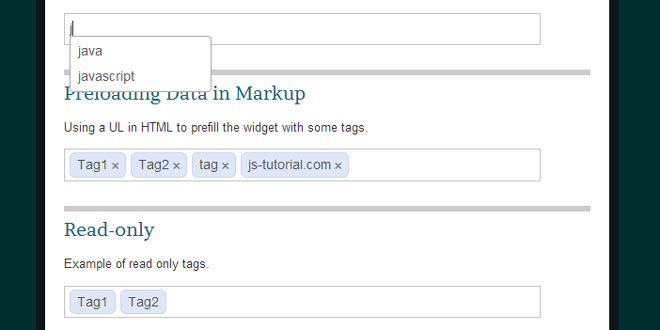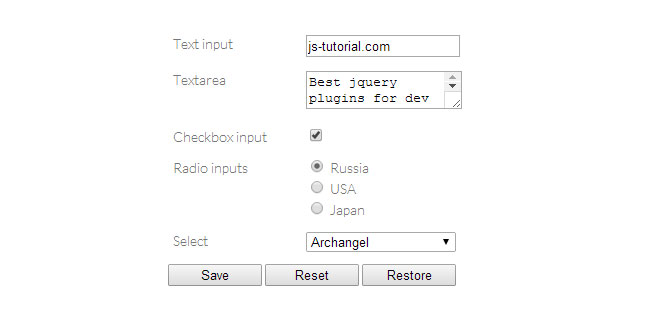- Overview
- Documents
jquery Tag-it is a jQuery UI plugin to handle multi-tag fields as well as tag suggestions/autocomplete.
- Actual extensible and idiomatic jQuery UI widget.
- The widget can be styled using Themeroller or any premade jQuery UI theme.
- Works with jQuery UI Bootstrap
- Degrades gracefully for browsers without JavaScript.
Source: aehlke.github.io
1. INCLUDE JS AND CSS FILES
<script src="http://ajax.googleapis.com/ajax/libs/jquery/1.5.2/jquery.min.js" type="text/javascript" charset="utf-8"></script> <script src="https://ajax.googleapis.com/ajax/libs/jqueryui/1.8.12/jquery-ui.min.js" type="text/javascript" charset="utf-8"></script> <script src="js/tag-it.js" type="text/javascript" charset="utf-8"></script> <link rel="stylesheet" type="text/css" href="http://ajax.googleapis.com/ajax/libs/jqueryui/1/themes/flick/jquery-ui.css"> <link href="css/jquery.tagit.css" rel="stylesheet" type="text/css">
2. HTML
<ul id="myTags">
<!-- Existing list items will be pre-added to the tags -->
<li>Tag1</li>
<li>Tag2</li>
</ul>
3. JAVASCRIPT
$(document).ready(function() {
$("#myTags").tagit();
});
4. OPTIONS
Tag-it accepts several options to customize its behaviour:
Each tag's hidden input field will have this name. If you're using PHP, you may want to use something like itemName[fieldName][] for this option's value.
$("#myTags").tagit({
fieldName: "skills"
});
Defaults to tags.
Used as source for the autocompletion, unless autocomplete.source is overridden.
$("#myTags").tagit({
availableTags: ["c++", "java", "php", "javascript", "ruby", "python", "c"]
});
If you define your own autocomplete.source, this option is unused (unless you choose to reference it yourself from your custom autocomplete.source of course.)
Defaults to an empty array [].
Allows overriding the source and select options that are set by default, as well as adding any other options you want to pass to the jQuery UI Autocomplete widget, such as minLength or delay.
The autocomplete.source should be overridden if you want to use custom autocompletion sources, like an Ajax / XHR response.
For example:
$("#myTags").tagit({
autocomplete: {delay: 0, minLength: 2}
});
The default autocomplete.source function filters the strings in availableTags and subtracts the already assigned tags. It also positions autocomplete underneath tag input.
showAutocompleteOnFocus (boolean)
Shows autocomplete when the tag input first receives focus, before the user even types anything.
If enabled, this will also make autocomplete.minLength default to 0 unless you override that, so that autocomplete can show up with a blank search.
Defaults to false.
When removeConfirmation is enabled the user has to press the backspace key twice to remove the last tag. After the first keypress the last tag receives a remove css class which can be used to visually highlight the tag.
Defaults to false.
whether the duplication check should do a case sensitive check or not.
Defaults to true.
Allows duplicate tags to be created. One implication of this is that removeTagByLabel will remove all tags which match the given label.
Defaults to false.
When allowSpaces is enabled the user is not required to wrap multi-word tags in quotation marks. For example, the user can enter John Smith instead of "John Smith".
Defaults to false.
When enabled, tag-it just render tags. It disables the ability to edit tags.
Defaults to false.
Limits the total number of tags that can be entered at once. Note that if you use this option with preloaded data, it may truncate the number of preloaded tags. Set to null for unlimited tags. See theonTagLimitExceeded callback for customizing this behavior.
Defaults to null.
When enabled, will use a single hidden field for the form, rather than one per tag. It will delimit tags in the field with singleFieldDelimiter.
Defaults to false, unless Tag-it was created on an input element, in which case singleField will be overridden as true.
Defaults to ","
Set this to an input DOM node to use an existing form field. Any text in it will be erased on init. But it will be populated with the text of tags as they are created, delimited by singleFieldDelimiter. If this is not set, we create an input node for it, with the name given in fieldName.
Defaults to null, unless Tag-it was created on an input element, in which case singleFieldNode will be overridden with that element.
Optionally set a tabindex attribute on the input that gets created for tag-it user input.
Defaults to null
Optionally set a placeholder attribute on the input that gets created for tag-it user input.
Defaults to null
5. METHODS
assignedTags()
Returns an array of the text values of all the tags currently in the widget.
$("#myTags").tagit("assignedTags");
createTag(tagLabel, additionalClass)
Adds new tag to the list. The additionalClass parameter is an optional way to add classes to the tag element.
$("#myTags").tagit("createTag", "brand-new-tag");
preprocessTag(function, Callback)
Set a function to be called before tag is created. Callback receives the value of the tag created.
// ensure all tags are capitalized
$(#tag-it").tagit("preprocessTag", function(val) {
if (!val) { return ''; }
return val[0].toUpperCase() + val.slice(1, val.length);
});
// foo -> Foo
removeTagByLabel(tagLabel, animate)
Finds the tag with the label tagLabel and removes it. If no such tag is found, it'll throw an exception.
$("#myTags").tagit("removeTagByLabel", "my-tag");
Clears the widget of all tags — removes each tag it contains, so the beforeTagRemoved /afterTagRemoved event callbacks (if set) will be called for each.
$("#myTags").tagit("removeAll");
6. EVENTS
beforeTagAdded (function, Callback)
Can be used to add custom behaviour before the tag is added to the DOM.
The function receives a null event, and an object containing the properties tag, tagLabel, andduringInitialization.
duringInitialization is a boolean indicating whether the tag was added during the initial construction of this widget, e.g. when initializing tag-it on an input with preloaded data. You can use this to tell whether the event was initiated by the user or by the widget's initialization.
To cancel a tag from being added, simply return false in your event callback to bail out from adding the tag and stop propagation of the event.
$("#myTags").tagit({
beforeTagAdded: function(event, ui) {
// do something special
console.log(ui.tag);
}
});
afterTagAdded (function, Callback)
Behaves the same as beforeTagAdded except that it fires after the tag has been added to the DOM. It too receives the duringInitialization parameter — see beforeTagAdded for details.
beforeTagRemoved (function, Callback)
Can be used to add custom behaviour before the tag is removed from the DOM.
To cancel a tag from being removed, simply return false in your event callback to bail out from removing the tag and stop propagation of the event.
The function receives a null event, and an object with tag and tagLabel properties.
$("#myTags").tagit({
beforeTagRemoved: function(event, ui) {
// do something special
console.log(ui.tag);
}
});
afterTagRemoved (function, Callback)
Behaves the same as beforeTagRemoved except that it fires after the tag has been removed from the DOM.
onTagExists (function, Callback)
Triggered when attempting to add a tag that has already been added in the widget. The callback receives a null event, and an object containing the properties existingTag and duringInitialization, since technically you could try to preload duplicate tags during the widget initialization.
If the allowDuplicates option is enabled, this will not be triggered.
By default it will visually highlight the existing tag, unless you return false in your callback.
onTagClicked (function, Callback)
Can be used to add custom behaviour when the tag is clicked. The function receives the click event and an objecting containing tag and tagLabel properties.
$("#myTags").tagit({
onTagClicked: function(event, ui) {
// do something special
console.log(ui.tag);
}
});
onTagLimitExceeded (function, Callback)
Called when attempting to create a tag while the tag limit has already been reached. Receives a null event, and an object with the property duringInitialization. This can only be called if tagLimit is set.
7. PROPERTIES
tagInput
The <input> field which is used for entering new tags. It's a jQuery object, so you may use it to add a class or anything to it, e.g.:
$("#myTags").tagit("tagInput").addClass("fancy");
 JS Tutorial
JS Tutorial




